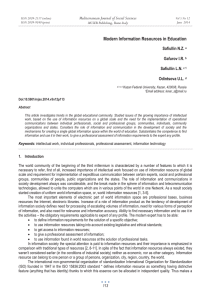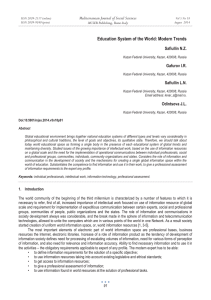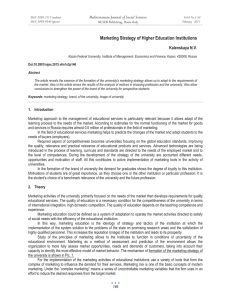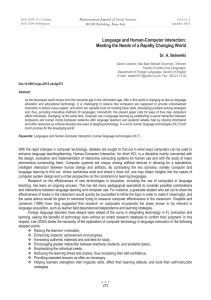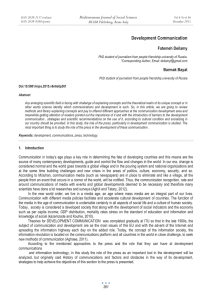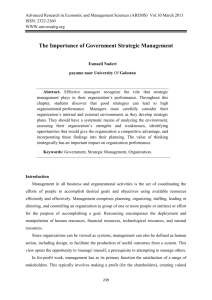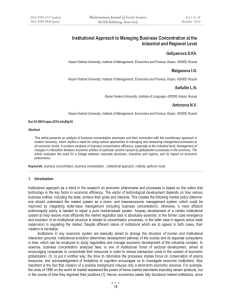Design of a Marketing Information System Mediterranean Journal of Social Sciences
advertisement
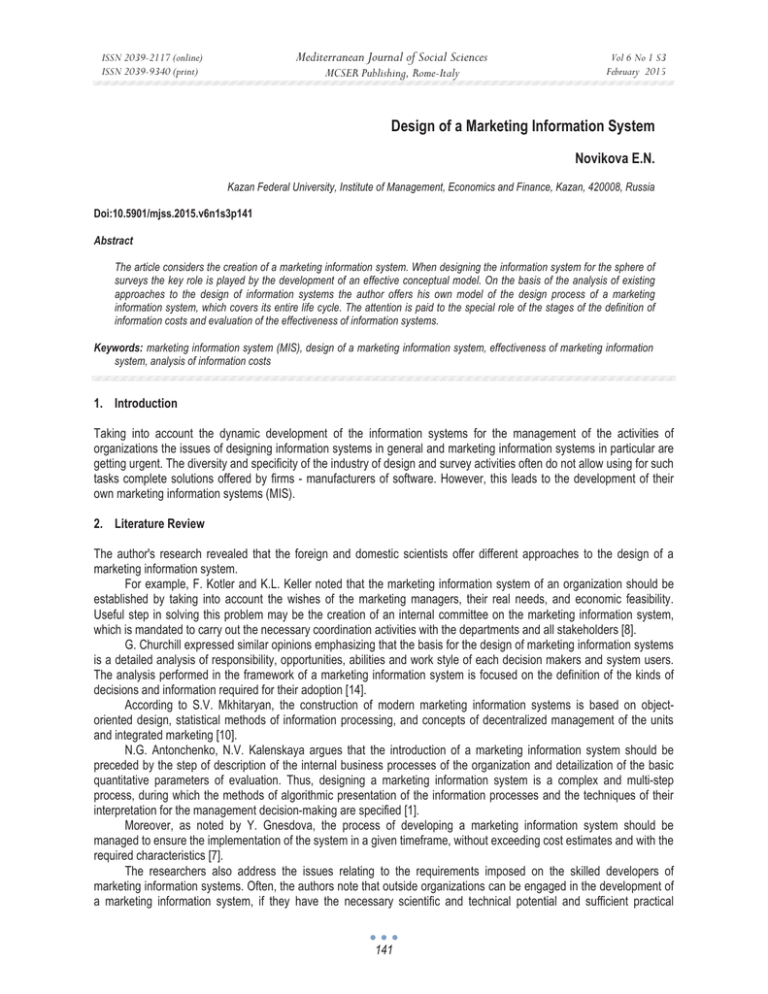
Mediterranean Journal of Social Sciences
ISSN 2039-2117 (online)
ISSN 2039-9340 (print)
MCSER Publishing, Rome-Italy
Vol 6 No 1 S3
February 2015
Design of a Marketing Information System
Novikova E.N.
Kazan Federal University, Institute of Management, Economics and Finance, Kazan, 420008, Russia
Doi:10.5901/mjss.2015.v6n1s3p141
Abstract
The article considers the creation of a marketing information system. When designing the information system for the sphere of
surveys the key role is played by the development of an effective conceptual model. On the basis of the analysis of existing
approaches to the design of information systems the author offers his own model of the design process of a marketing
information system, which covers its entire life cycle. The attention is paid to the special role of the stages of the definition of
information costs and evaluation of the effectiveness of information systems.
Keywords: marketing information system (MIS), design of a marketing information system, effectiveness of marketing information
system, analysis of information costs
1. Introduction
Taking into account the dynamic development of the information systems for the management of the activities of
organizations the issues of designing information systems in general and marketing information systems in particular are
getting urgent. The diversity and specificity of the industry of design and survey activities often do not allow using for such
tasks complete solutions offered by firms - manufacturers of software. However, this leads to the development of their
own marketing information systems (MIS).
2. Literature Review
The author's research revealed that the foreign and domestic scientists offer different approaches to the design of a
marketing information system.
For example, F. Kotler and K.L. Keller noted that the marketing information system of an organization should be
established by taking into account the wishes of the marketing managers, their real needs, and economic feasibility.
Useful step in solving this problem may be the creation of an internal committee on the marketing information system,
which is mandated to carry out the necessary coordination activities with the departments and all stakeholders [8].
G. Churchill expressed similar opinions emphasizing that the basis for the design of marketing information systems
is a detailed analysis of responsibility, opportunities, abilities and work style of each decision makers and system users.
The analysis performed in the framework of a marketing information system is focused on the definition of the kinds of
decisions and information required for their adoption [14].
According to S.V. Mkhitaryan, the construction of modern marketing information systems is based on objectoriented design, statistical methods of information processing, and concepts of decentralized management of the units
and integrated marketing [10].
N.G. Antonchenko, N.V. Kalenskaya argues that the introduction of a marketing information system should be
preceded by the step of description of the internal business processes of the organization and detailization of the basic
quantitative parameters of evaluation. Thus, designing a marketing information system is a complex and multi-step
process, during which the methods of algorithmic presentation of the information processes and the techniques of their
interpretation for the management decision-making are specified [1].
Moreover, as noted by Y. Gnesdova, the process of developing a marketing information system should be
managed to ensure the implementation of the system in a given timeframe, without exceeding cost estimates and with the
required characteristics [7].
The researchers also address the issues relating to the requirements imposed on the skilled developers of
marketing information systems. Often, the authors note that outside organizations can be engaged in the development of
a marketing information system, if they have the necessary scientific and technical potential and sufficient practical
141
ISSN 2039-2117 (online)
ISSN 2039-9340 (print)
Mediterranean Journal of Social Sciences
MCSER Publishing, Rome-Italy
Vol 6 No 1 S3
February 2015
experience, but it also requires the participation of a number of experts from the organization itself. E.U. Mardanova
expresses a different view based on the fact that the best method of organizing the work with information, in terms of
correlation "the price - the results", is an independent design of marketing information systems, as the fundamental
advantage of this approach is the ability to considerate the specificity of an organization [9].
It should be noted that many authors suggest ideas about the necessity of organic integration of a marketing
information system in the higher-order system, in particular, corporate information systems, which corresponds to modern
trends of globalization of the economic activity.
However, the authors pay much attention to the issues related to the life cycle of marketing information systems.
Nitayaprapha S., Atkinson C.J. identifies the following stages of the development of information system [12]:
1) Identification of potential users of the information system - the persons responsible for making decisions;
2) Determination of their information needs;
3) Definition of the data that should be entered into the system, as well as methods for their protection and
storage, access and integration;
4) Realization of direct "construction" of the system, that is the task of programmers who write and document
programs;
5) Debugging of all procedures, checking the accuracy of the system;
6) Operation of the system in the interactive mode.
The process of designing a marketing information system, according to E.U. Mardanova, consists of the following
stages [9]:
1) Development of types and structure of the reports needed for decision-making by managers of different levels;
2) Reporting electronically;
3) Identification of the main streams of incoming information and their primary processing algorithms;
4) Identifying relevant sources of information;
5) Approval of marketing information obtaining technology, timing, determination of budgets and responsibilities
for data;
6) Creation and adoption of the technology of getting generalized knowledge from the accumulated experience.
On the basis of the assumptions of the theory of change management, L.I. Bushueva identifies the following stages
of implementation of the system of information support of marketing activities [5]:
1) Preparation;
2) Defrostation (training staff to change);
3) Change;
4) Freezing (consolidation of changes).
According to the author of the article, A.P. Tyapukhin and M.N. Satarova presented the most detailed process of
designing a marketing information system. Focusing on the classification features such as horizon of planning a
marketing information system activity and the challenges facing the organization, these scientists formulated the following
stages of creating and functioning of the marketing information system [13]:
1) Project development;
2) Forming
3) Maintenance of activity;
4) Optimization.
More detailed approach, the authors use to structure the process of designing a marketing information system,
allows you to highlight the steps listed below:
1) Definition of the scope of work to be carried out by the system (it is obvious that the structure and content of
this stage are unique to each organization);
2) Identification of basic and auxiliary functions performed within the marketing information system;
3) Structuring functions to the operation (designers should make a choice in the orientation of the work of
performers either on the implementation technology, or on individual processes; the second direction, as
practice shows, now seems more promising);
4) Determination of the required number of resources: material, financial, information and human;
5) Formation of the elements of a marketing information system, namely: personnel by specialties and levels of
expertise, equipment and technology, conducting work, resources, control systems, etc.;
6) Construction of the organizational structure of the marketing information system management, development of
the personnel motivation system;
7) Securing the organizational, functional and legal aspects of the building a marketing information system in the
142
ISSN 2039-2117 (online)
ISSN 2039-9340 (print)
Mediterranean Journal of Social Sciences
MCSER Publishing, Rome-Italy
Vol 6 No 1 S3
February 2015
documents;
8) Developing a plan of forming a marketing information system (it is advisable to use the methods of network
planning and project management).
However, it should be considered, what kind of issues may arise, when designing a marketing information system.
So, E.U. Mardanova describes the following barriers that may be faced by the management in implementing of a
marketing information system [9]:
- Technological (lack of software due to its high cost, lack of formalization of management processes);
- Institutional (opposition of the organizational culture to the implementation of information system);
- Personal (unwillingness to perform additional work);
- Other (presence of previous negative experiences).
3. Method
Thus, in the process of building and developing a marketing information system it is necessary to identify the problems
that may arise, and develop activities aimed at their elimination. After analyzing all of the above approaches to the design
of marketing information systems, developed by domestic and foreign scholars, the author proposes an improved
algorithm of the marketing information system design process, presented in Fig. 1.
A special feature of this algorithm is a systematic approach covering all stages of the life cycle of the information
system and all the possible options for its development on the basis of the results of evaluation of the effectiveness of its
activities.
Figure 1. Algorithm of the marketing information system design
143
ISSN 2039-2117 (online)
ISSN 2039-9340 (print)
Mediterranean Journal of Social Sciences
MCSER Publishing, Rome-Italy
Vol 6 No 1 S3
February 2015
The design process is also based on an analysis of information costs of a marketing information system. The methods of
analysis of information costs of the marketing system are described by the author in [15]. The result of implementing the
stages of the proposed design process of a marketing information system is to build the structure, taking into account the
characteristics of the organization and the system of information support for its activities.
4. Results
This conceptual model was used to develop the marketing information system for a big design and survey provider of the
Republic of Tatarstan JSC Institute "Kazan Promstroiproekt". The structure of the designed information system includes
the following subsystems:
- Subsystem of internal reporting, which collects, analyzes, distributes accounting data; information on
contracts, performed design works; information on subcontractors, suppliers, etc .;
- Marketing supervision subsystem, that handles the largest volume of information. It includes an extensive
component covering regulations, technical and scientific information, the presence of which is required to
ensure a high quality of design and survey works. This subsystem also includes information related to the
industry associations, self-regulatory organizations; industry surveys; periodical literature, books, monographs
of the specialized and general economic nature; information related to tenders and competitions; information
received at the exhibitions, etc.;
- Subsystem of marketing research (research of customers, competitors, suppliers), which is often virtually
absent in information systems of design and survey organizations, but has a great potential to improve the
effectiveness of marketing activities.
Draft structure of marketing information system by the example of design and survey organizations proved the
effectiveness of the proposed approach. The developed system of marketing information is characterized by such
indicators of functioning quality as: 1) efficiency; 2) reliability; 3) sustainability.
5. Conclusion
This article describes the conceptual model of designing a marketing information system of a design and survey
organization. A feature of this model is a systematic approach and an emphasis on the design stages such as analysis of
information costs and evaluation of the functioning effectiveness of the information system of the design and survey
provider. Testing procedure of the methods was performed on the example of one of the largest R&D organization of the
Republic of Tatarstan - JSC Institute "Kazan Promstroiproekt". The author of the article examined the structure of the
designed marketing information system, and made recommendations to improve the functioning of the information
system of the analyzed organization.
References
Antonchenko N.G., Kalenskaya N.V. Developing a Methodology for Assessing the Efficacy of Managerial Decisions in Entrepreneurial
Establishments. // Life Science Journal. – 2014. - ʋ 11(7s).
Atkinson, C., Brooks, L. Ethical moments within the Soft Information Systems & Technologies Methodology (SISTeM) //15th Americas
Conference on Information Systems 2009, AMCIS 2009, Volume 7, 2009, pp. 4873-4882
Achouri, A., Atkinson, C. The study of different methodologies in modelling information systems: SSM vs SISTeM // Information
Management in the Modern Organizations: Trends and Solutions - Proceedings of the 9th International Business Information
Management Association Conference, Volume 1-2, 2008, pp. 379-385
Bogliacino, F., Cardona, S.G. Capabilities and investment in R&D: An analysis on European data// Structural Change and Economic
Dynamics, Volume 31, December 01, 2014, pp. 101-111
Chen, M., Zhang, X. Value co-creation of R and D services: Based on the perspective of value // Proceedings - 2013 International
Conference on Computational and Information Sciences, ICCIS 2013, 2013, Article number 6643364, pp. 1705-1708
Kotler F., Keller K.L. Marketing Management. Express Course. - 2nd ed.: Trans. from English. / Kotler F. - SPb.: Piter, 2006 – 816 p.
Mardanova E.U. Organizing Activities with Information in Order to Make Management Decisions / Mardanova E.U. // Marketing and
Marketing research. - 2007. - ʋ 4. - pp. 258-265.
Mkhitaryan S.V. Marketing Information System / Mkhitaryan S.V. – M.: Publisher «Eksmo», 2006. - 112 p.
Mustafa, H., Sori, Z.M., Ahmad, A.C., Mahussin, N. A study of user information satisfaction on financial management information system
('Sistem Maklumat Pengurusan Kewangan') // International Research Journal of Finance and Economics,Volume 36, Issue 1,
February 2010, pp. 121-132
Ulesov D.N., Shigabieva A.M., Safiullin L.N., Shaidullin R.N. Essential features of small and medium business. Life Science Journal
144
ISSN 2039-2117 (online)
ISSN 2039-9340 (print)
Mediterranean Journal of Social Sciences
MCSER Publishing, Rome-Italy
Vol 6 No 1 S3
February 2015
2014; 11(6s): 392 – 395.
Kramin, M. V., Safiullin, L. N., Kramin, T. V., & Timiryasova, A. V. (2014). Drivers of economic growth and investment attractiveness of
Russian regions. Life Science Journal, 11(6s).
Kramin, T. V., Ismagilova, G. N., & Kramin, M. V. (2014). Assessment of Effect of Large Investment Projects on Development of
Investment Potential of Regions of Russia as Exemplified by Universiade 2013 in Kazan1. Mediterranean Journal of Social
Sciences, 5(18), 255.
Kramin, T. V., Safiullin, L. N., & Timiryasova, A. V. (2014). Defining Priorities of Management of Investment Attractiveness of the Region
and their Consideration in the Framework of Implementing Large Sports Events1. Mediterranean Journal of Social Sciences,
5(18), 275.
Novikova E., Beloborodova A. An Assessment of the Efficiency of the Information System of Design-and-survey Organizations Based on
the Analysis of the Information Capacity of Projects Implemented // World Applied Sciences Journal. - 2014, ʋ29 (1), pp.20-25.
Panasyuk, M.V., Gafurov, I.R., Novenkova, A.Z. Influence of international transport and logistics systems on economic development of
the region // World Applied Sciences Journal, 27(13), 2013, 135-139.
Ismagilova G.N., Safiullin L.N., Novenkova A.Z., Safiullin N.Z. Prospects of small business in Tatarstan. Life Science Journal 2014;
11(6s): 396 – 399.
145
